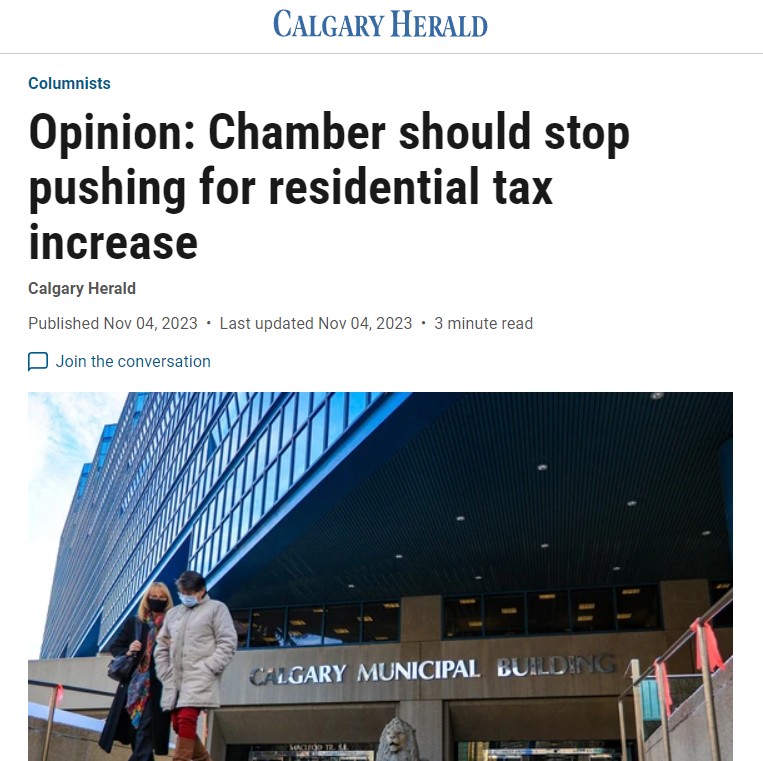SecondStreet.org research shows the city spent more on top-up pensions ($10.9 million) for its staff in 2018 than Edmonton, Montreal, Toronto, Ottawa, Mississauga, Brampton, Halifax, Vancouver, Winnipeg and Saskatoon combined. Yes, combined.
CALGARY HERALD COLUMN: Chamber Should Stop Pushing for Residential Tax Increase

Calgary’s economy has been through a lot over the past decade. From a recession and a pandemic to high inflation, both businesses and families have felt the pinch financially.
With that in mind, it’s disappointing that Deborah Yedlin and the Calgary Chamber of Commerce are continuing to push for families to pay more in taxes. They continue to do this by lobbying city hall to collect a larger portion of its revenues from homeowners and a smaller portion from businesses.
There is a better approach.
Imagine if the city reduced inefficient spending instead of raising taxes. That would help both businesses and the people who shop in their stores — everyday Calgarians.
Understandably, the chamber wants to ease the tax burden its members are paying — city hall’s tax increases have been severe. Many readers will remember how businesses around the city began disclosing the large tax increases they faced a few years ago. The former German restaurant Wurst noted on its large outdoor sign that its 2014 property taxes were “$74k” and rose to “$208k” in 2019. It has since gone out of business.
At city hall, we find a very different scene. Despite claims by the city that it has tightened its belt, total expenditures have increased 20 per cent since 2015. Life has remained comfortable there while those outside of government circles have struggled.
Note that in 2018, three years after Calgary’s economy went into a recession, the city’s administration was spending nearly $8 million each year on retirement bonuses for staff — bonuses that were completely detached from performance. You could literally be the worst-performing employee in the city government but still receive a large handout on the way out the door.
This anecdote is important for two reasons.
First, it’s council’s job to look under every stone for savings. Clearly, that wasn’t happening as it took a third party to expose this problem (I exposed this issue while working for the Canadian Taxpayers Federation).
Second, council can’t count on city administration to bring forward reasonable ideas on how to reduce spending on compensation for city staff — they face an obvious conflict of interest.
Readers should consider another compensation issue that continues to burn quietly at city hall: pension costs.
Outside of government, less than one in four workers has a workplace pension. But at the City of Calgary, not only do the vast majority of employees receive a pension, nearly two thousand city employees will also receive a generous top-up pension when they retire. In fact, more than 200 city employees will receive three city pensions when they retire. Must be nice.
The basic pension plan that almost all city employees receive, the Local Authorities Pension Plan, is also quite generous. It cost the city $76 million in 2009, but by 2019, the annual cost for this pension had ballooned to $137 million. Why hasn’t council tackled this problem, considering it has ballooned so much? Perhaps councillors are concerned that doing so would draw more attention to their own golden pensions?
While many private sector employees have taken at least one pay reduction over the past decade, city data shows there has never been a pay reduction for its main bargaining units over the past 49 years.
The easiest way to address these issues would be for the city to phase in lower, more reasonable compensation packages for new staff.
Hopefully, the chamber can see there are plenty of opportunities for savings. The people who shop at Calgary businesses and dine in local restaurants can’t afford to pay more to city hall.
Colin Craig is the president of SecondStreet.org, a Calgary-based, conservative-leaning think-tank.
This column was originally published in The Calgary Herald on November 4, 2023.
You can help us continue to research and tell stories about this issue by making a donation or sharing this content with your friends. Be sure to sign up for our updates too!


